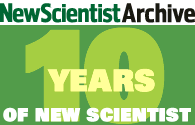 |
 |
|
• Subscribe • Renew • Change address |
|
Best live jobs in the hottest areas of sciences
Cell Biology Software Engineering Genetics Analytical Chemistry Sales & Marketing Or search all of our jobs and opportunities |
| The World's No.1 Science & Technology News Service |
|
Milky Way spiral gets an extra arm |
|||||||||||||||||||||||||||||||||||||||||
| 10:15 09 May 04 | |||||||||||||||||||||||||||||||||||||||||
| Exclusive from New Scientist Print Edition. Subscribe and get 4 free issues. | |||||||||||||||||||||||||||||||||||||||||
|
The map of the Milky Way is being redrawn, following the discovery of another arm of the galaxy. The structure consists of an arc of hydrogen gas 77,000 light years long and a few thousand light years thick running along the galaxy's outermost edge. "We see it over a huge area of sky," says Naomi McClure-Griffiths of the Australia National Telescope Facility in Epping, New South Wales, who led the team that made the discovery.
Astronomers are shocked that the feature has been overlooked until now. "I was absolutely flabbergasted, it was quite clearly seen in some of the previous surveys but it was never pointed out or given a name," says Tom Dame at the Harvard-Smithsonian Center for Astrophysics in Cambridge, Massachusetts.
Scientists have known for 50 years that the Milky Way has a spiral structure, and careful observations have identified four main arms that swirl out from the galactic centre as well a number of smaller arcs between them. The new feature is a massive arc that sweeps around outside the other arms. If it were visible in the night sky on Earth it would reach approximately from the horizon to the zenith. McClure-Griffiths and colleagues made their discovery while mapping the distribution of hydrogen gas within the Milky Way, a project known as the Southern Galactic Plane Survey. Most of the Milky Way is obscured by clouds of dust. But hydrogen emits radio waves which pass through the interstellar dust clouds, so when McClure-Griffiths saw an unexpected ridge of bright emission in the radio map she wondered whether it might be a new feature of the galaxy. To test this hunch, she developed a simple computer model of a spiral galaxy to show how hydrogen gas should be distributed. This model closely reproduced the known distribution of hydrogen in the Milky Way, she says in a report to be published in Astrophysical Journal Letters. The new arc also fitted the model, convincing the team that the feature was real. Further evidence that the feature is part of the Milky Way is that the arm is rotating with the rest of the galaxy, says Robert Benjamin, an astronomer at the University of Wisconsin in Whitewater.
The arc could be a tendril that once joined up with another spiral arm, McClure-Griffiths says. It would not be unusual for a mid-sized galaxy like ours to have arms that extend so far - the Andromeda galaxy, which is similar to ours, has long gaseous arms. Another possibility is that the gas was drawn out of the Milky Way in a collision with a dwarf galaxy early in its evolution.
The next step will be to characterise the make-up of the arm in more detail. In 2003, a group of astronomers, including Brian Yanny of Fermilab in Batavia, Illinois, found a streak of stars along the rim of the Milky Way 60,000 light years from the middle, near to the new arc of gas. Whether these stars are part of the new arm is not clear, however. Their composition suggests that they came from a small invading galaxy that was torn apart as it brushed past the Milky Way, says Yanny. In this case, the stars' alignment with the arm could be mere coincidence. However, he is planning to run simulations to determine whether such a brush may have created the new feature on the Milky Way map. Benjamin says that, in the last few years, surveys of the sky by robotic telescopes have inundated astronomers with information about the Milky Way. That is why he thinks the arm "probably won't be the last major galactic structure to be discovered". |
|||||||||||||||||||||||||||||||||||||||||
|
Jenny Hogan |
|||||||||||||||||||||||||||||||||||||||||
| For what's in New Scientist magazine this week see Print Edition | ||
| Search the Archive for more stories like this, originally published in the Print Edition | ||
| Subscribe to New Scientist Print Edition | ||
| Contact us about this story | ||
| Sign up for our free newsletter | ||

|
 | ||||
 | ||||
 | ||||
All the best science stories from the web |
Study of antidepressants finds little disparity in suicide risk New York Times (free registration required) |
Martian meteor discovered in Antarctica ABC News, Australia |
US clears botox to treat severe sweating Los Angeles Times (free registration required) |

| ADVERTISEMENTS |
| For unbiased reviews of hotels, resorts & vacations useTripAdvisor.com Hotels Vacations Caribbean hotels Hotels in England Hotels in the USA California hotels Las Vegas hotels Atlantic City hotels San Francisco hotels Los Angeles hotels |
| Advice on personal & corporate finance at Prudent Minds Finance Guide Credit Cards Insurance Investments Loans Mortgages Pensions Savings |
|
FlightComparison.co.uk - Unbiased Cheap Flight comparison from the UK to all destinations. Cheap Flights Cheap Flights to Sydney, Australia Cheap Hotels Electrical Appliances and Electronics |
|
A Quote Insurance. Free instant quotes! Car Insurance Quotes by A Quote Van Insurance Quotes by A Quote Bike Insurance Quotes by A Quote Home Insurance Quotes by A Quote Motor Insurance Quotes by A Quote |
|
About newscientist.com •
Subscribe •
Contact Us •
FAQ •
Media Information •
Disclaimer •
Terms and Conditions •
Site Map •
Cookies •
Privacy Policy
© Copyright Reed Business Information Ltd. |
